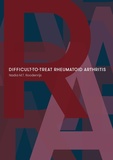Difficult-to-treat rheumatoid arthritis
Summary
Despite significant improvement in the management of rheumatoid arthritis (RA), a substantial proportion of patients remains symptomatic after treatment with multiple biological and/or targeted synthetic (b/ts)DMARDs according to European League Against Rheumatism (EULAR) RA management recommendations. These patients can be referred to as having ‘difficult-to-treat’ (D2T) RA. Current management recommendations mainly focus on the early phase of the disease and on pharmacological management. Less guidance is available for the management of D2T RA, which is also hampered by the lack of uniform terminology and a definition, although its management often is a true clinical challenge.
In this thesis, the concept of D2T RA has been formalised with the EULAR definition. D2T RA is shown to be a heterogeneous disease state in which one or multiple factors may contribute to the persistence of signs and/or symptoms. The heterogeneity of D2T RA should be acknowledged in daily practice and warrants a holistic approach. Despite the scarcity of (high-quality) evidence, the management of D2T RA patients can now be guided by the consensus-based EULAR recommendations. As first step, the diagnosis of RA should be ascertained. Then, the presence or absence of inflammatory disease activity should be evaluated as well as all factors potentially contributing to D2T to identify the origin of the patient’s current signs and symptoms. These outcomes should guide individualised pharmacological and/or non-pharmacological therapeutic strategies.
The patients’, rheumatologists’ and economic burden of D2T RA are significant, which substantiates the need for a swift implementation of the abovementioned recommendations in daily practice to decrease the burden of D2T RA. Additionally, more research into D2T RA is needed to increase our understanding of the underlying immunology, to further optimise diagnostics and therapeutic strategies, and to determine factors that could facilitate early identification and treatment stratification and, with that, to improve outcomes of D2T RA patients.
